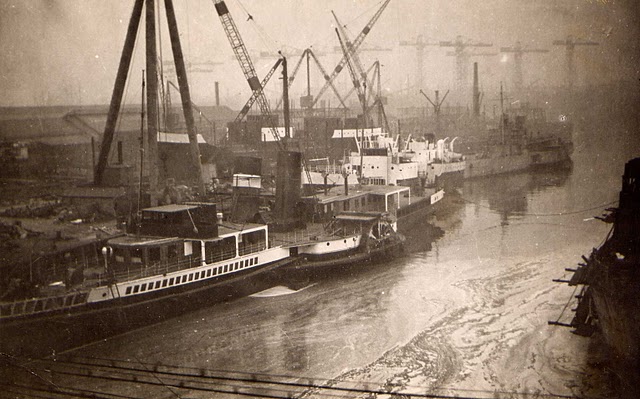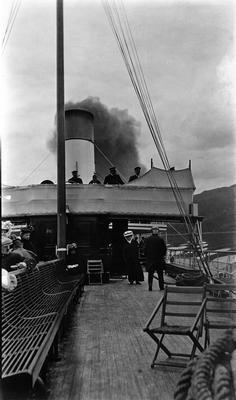|
A And J Inglis
A & J Inglis, Ltd, was a shipbuilding firm founded by Anthony Inglis and his brother John, engineers and shipbuilders in Glasgow, Scotland in 1862. The firm built over 500 ships in a period of just over 100 years. Their Pointhouse Shipyard was at the confluence of the rivers Clyde and Kelvin. They constructed a wide range of ships, including Clyde steamers, paddle steamers and small ocean liners. In wartime, they built small warships, and in the period after World War II, they built a number of whalers. History A & J Inglis of Glasgow was formed in 1848 as an engineering works. Thomas B. Seath founded the shipyard at Pointhouse in 1845 and it was acquired by A & J Inglis in 1862. In 1884 Anthony Inglis died and his son John Inglis took over. John Inglis himself, was well known for many maritime activities. In 1885 they launched 11 ships with a total tonnage of 7,470 tons. In 1867, a ''Patent Slip Dock'' for ship repairs was built at Pointhouse. This was an innovative alte ... [...More Info...] [...Related Items...] OR: [Wikipedia] [Google] [Baidu] |
A And J Inglis
A & J Inglis, Ltd, was a shipbuilding firm founded by Anthony Inglis and his brother John, engineers and shipbuilders in Glasgow, Scotland in 1862. The firm built over 500 ships in a period of just over 100 years. Their Pointhouse Shipyard was at the confluence of the rivers Clyde and Kelvin. They constructed a wide range of ships, including Clyde steamers, paddle steamers and small ocean liners. In wartime, they built small warships, and in the period after World War II, they built a number of whalers. History A & J Inglis of Glasgow was formed in 1848 as an engineering works. Thomas B. Seath founded the shipyard at Pointhouse in 1845 and it was acquired by A & J Inglis in 1862. In 1884 Anthony Inglis died and his son John Inglis took over. John Inglis himself, was well known for many maritime activities. In 1885 they launched 11 ships with a total tonnage of 7,470 tons. In 1867, a ''Patent Slip Dock'' for ship repairs was built at Pointhouse. This was an innovative alte ... [...More Info...] [...Related Items...] OR: [Wikipedia] [Google] [Baidu] |
Robert Napier (engineer)
Robert Napier (21 June 1791 – 23 June 1876) was a Scottish marine engineer known for his contributions to Clyde shipbuilding. Early life Robert Napier was born in Dumbarton at the height of the Industrial Revolution, to James and Jean Napier. James was of a line of esteemed bell-wrights, blacksmiths, and engineers, with a brother (also named Robert) who served as blacksmith for the Duke of Argyll at Inveraray Castle. Napier was educated at the burgh school where he took an interest in drawing, which reflected in his later life in an interest in painting and fine arts. Against his father's hopes that he would become a minister in the Church of Scotland, he developed an interest in the family business. At age sixteen, he was confronted by a Royal Navy press gang who intended to conscript him into service during the Napoleonic Wars. Instead of allowing his son to be conscripted, James Napier signed a contract of formal indenture with his son, making him immune to conscription. ... [...More Info...] [...Related Items...] OR: [Wikipedia] [Google] [Baidu] |
TS King Edward
TS ''King Edward'' was an excursion steamer built at Dumbarton for service down the River Clyde to the Firth of Clyde and associated sea lochs on the west coast of Scotland, as far as Campbeltown. The first commercial vessel to be driven by steam turbines, ''King Edward'' was remarkably successful for a prototype, serving as a Clyde steamer for half a century from 1901 until 1951, interrupted only by service in the two world wars. The success of the vessel quickly led to the adoption of turbine propulsion for all manner of merchant vessels, from channel ferries and coastal steamers to transatlantic liners. Background In 1803, showed the practicality of steam power for marine use, and in 1812 Henry Bell's began the first commercially successful steamboat service in Europe, sailing on the River Clyde between Glasgow and Helensburgh. Others soon followed, and by mid century a large fleet of Clyde steamers competed for holiday and excursion traffic down the River and Firth of Cl ... [...More Info...] [...Related Items...] OR: [Wikipedia] [Google] [Baidu] |
Loch Lomond
Loch Lomond (; gd, Loch Laomainn - 'Lake of the Elms'Richens, R. J. (1984) ''Elm'', Cambridge University Press.) is a freshwater Scottish loch which crosses the Highland Boundary Fault, often considered the boundary between the lowlands of Central Scotland and the Highlands.Tom Weir. ''The Scottish Lochs''. pp. 33-43. Published by Constable and Company, 1980. Traditionally forming part of the boundary between the counties of Stirlingshire and Dunbartonshire, Loch Lomond is split between the council areas of Stirling, Argyll and Bute and West Dunbartonshire. Its southern shores are about northwest of the centre of Glasgow, Scotland's largest city. The Loch forms part of the Loch Lomond and The Trossachs National Park which was established in 2002. Loch Lomond is long and between wide, with a surface area of . It is the largest lake in Great Britain by surface area; in the United Kingdom, it is surpassed only by Lough Neagh and Lough Erne in Northern Ireland. In the Briti ... [...More Info...] [...Related Items...] OR: [Wikipedia] [Google] [Baidu] |
A And J Inglis No 290 Weerdoona (1910)
A, or a, is the first letter and the first vowel of the Latin alphabet, used in the modern English alphabet, the alphabets of other western European languages and others worldwide. Its name in English is ''a'' (pronounced ), plural ''aes''. It is similar in shape to the Ancient Greek letter alpha, from which it derives. The uppercase version consists of the two slanting sides of a triangle, crossed in the middle by a horizontal bar. The lowercase version can be written in two forms: the double-storey a and single-storey ɑ. The latter is commonly used in handwriting and fonts based on it, especially fonts intended to be read by children, and is also found in italic type. In English grammar, " a", and its variant " an", are indefinite articles. History The earliest certain ancestor of "A" is aleph (also written 'aleph), the first letter of the Phoenician alphabet, which consisted entirely of consonants (for that reason, it is also called an abjad to distinguish ... [...More Info...] [...Related Items...] OR: [Wikipedia] [Google] [Baidu] |
Royal Yacht
A royal yacht is a ship used by a monarch or a royal family. If the monarch is an emperor the proper term is imperial yacht. Most of them are financed by the government of the country of which the monarch is head. The royal yacht is most often crewed by personnel from the navy and used by the monarch and his/her family on both private and official travels. Types of vessels used Some royal yachts have been/are small vessels only used for short trips on rivers or in calm waters, but others have been/are large seaworthy ships. History Depending on how the term is defined royal yachts date back to the days of antiquity with royal barges on the Nile in ancient Egypt. Later the Vikings produced royal vessels. They followed the pattern of longships although highly decorated and fitted with purple sails (purple sails remained standard for royal vessels the next 400 years). In England, Henry V sold off the royal yachts to clear the Crown's debts. The next royal vessels in England were ... [...More Info...] [...Related Items...] OR: [Wikipedia] [Google] [Baidu] |
Norman Court Clipper
Norman or Normans may refer to: Ethnic and cultural identity * The Normans, a people partly descended from Norse Vikings who settled in the territory of Normandy in France in the 10th and 11th centuries ** People or things connected with the Norman conquest of southern Italy in the 11th and 12th centuries ** Norman dynasty, a series of monarchs in England and Normandy ** Norman architecture, romanesque architecture in England and elsewhere ** Norman language, spoken in Normandy ** People or things connected with the French region of Normandy Arts and entertainment * ''Norman'' (film), a 2010 drama film * '' Norman: The Moderate Rise and Tragic Fall of a New York Fixer'', a 2016 film * ''Norman'' (TV series), a 1970 British sitcom starring Norman Wisdom * ''The Normans'' (TV series), a documentary * "Norman" (song), a 1962 song written by John D. Loudermilk and recorded by Sue Thompson * "Norman (He's a Rebel)", a song by Mo-dettes from '' The Story So Far'', 1980 Businesses ... [...More Info...] [...Related Items...] OR: [Wikipedia] [Google] [Baidu] |
A And J Inglis No 26 Erl King (1865)
A, or a, is the first letter and the first vowel of the Latin alphabet, used in the modern English alphabet, the alphabets of other western European languages and others worldwide. Its name in English is ''a'' (pronounced ), plural ''aes''. It is similar in shape to the Ancient Greek letter alpha, from which it derives. The uppercase version consists of the two slanting sides of a triangle, crossed in the middle by a horizontal bar. The lowercase version can be written in two forms: the double-storey a and single-storey ɑ. The latter is commonly used in handwriting and fonts based on it, especially fonts intended to be read by children, and is also found in italic type. In English grammar, " a", and its variant " an", are indefinite articles. History The earliest certain ancestor of "A" is aleph (also written 'aleph), the first letter of the Phoenician alphabet, which consisted entirely of consonants (for that reason, it is also called an abjad to distinguish ... [...More Info...] [...Related Items...] OR: [Wikipedia] [Google] [Baidu] |
Riverside Museum
The Riverside Museum (formerly known as the Glasgow Museum of Transport) is a museum in Glasgow, housed in a building at Pointhouse Quay in the Glasgow Harbour regeneration district of Glasgow, Scotland. The building opened in June 2011, winning the 2013 European Museum of the Year Award. It houses many exhibits of national and international importance. The Govan-Partick Bridge will provide a pedestrian link from the museum across the Clyde to Govan. It is set to be completed in 2023. History 1964–2011 The Museum of Transport was opened on 14 April 1964 by Queen Elizabeth The Queen Mother. Created in the wake of the closure of Glasgow's tramway system in 1962, it was initially located at the former Coplawhill tram depot on Albert Drive in Pollokshields, before moving to the Kelvin Hall in 1988. The old building was subsequently converted into the Tramway arts centre. The museum was then situated inside the Kelvin Hall opposite the Kelvingrove Art Gallery & Museum in the ... [...More Info...] [...Related Items...] OR: [Wikipedia] [Google] [Baidu] |


.jpg)

_2017-08-16.jpg)
